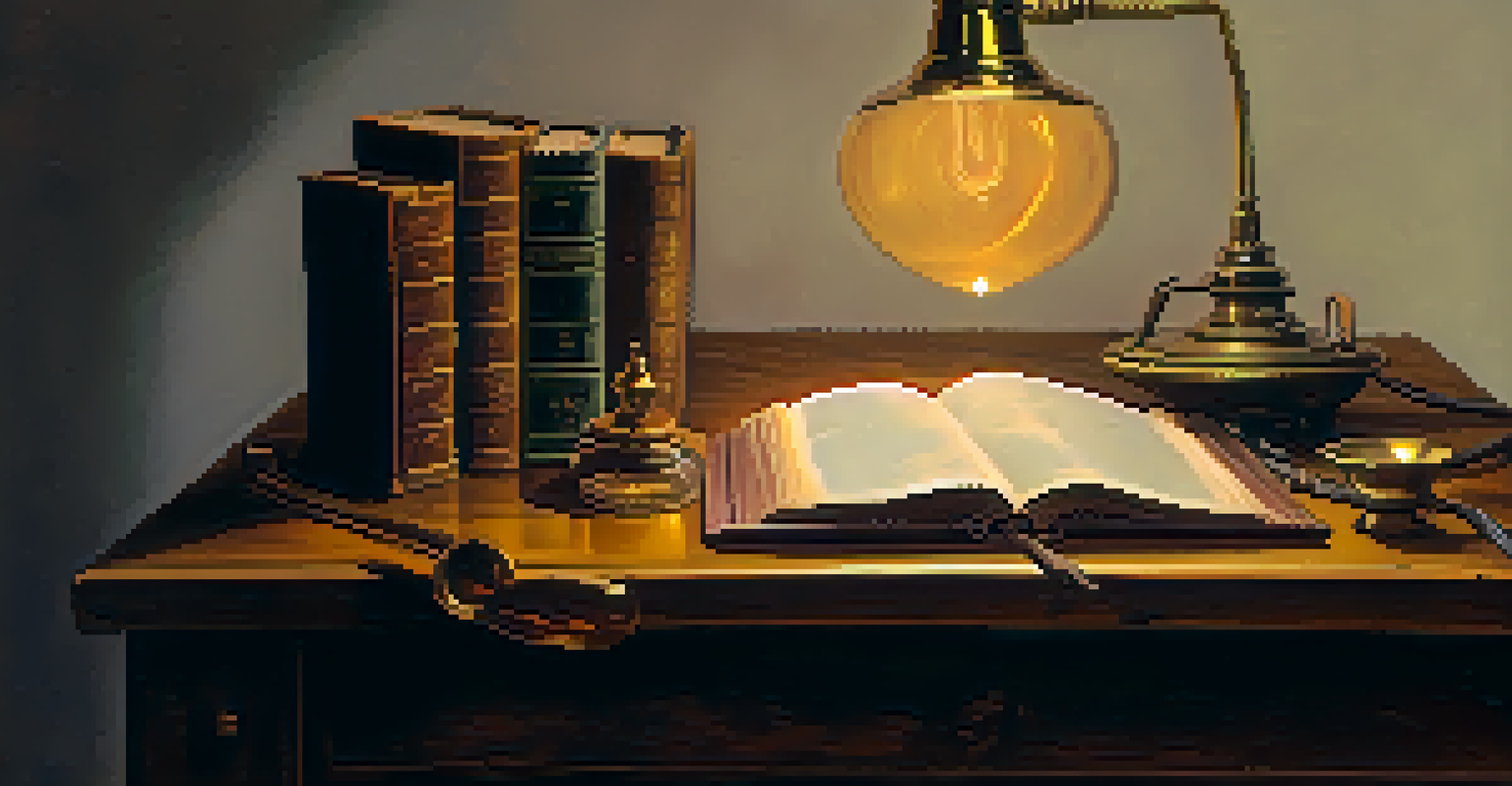Chiaroscuro: Light, Shadow, and Musical Dynamics in Art

Understanding Chiaroscuro: The Basics of Light and Shadow
Chiaroscuro is an artistic technique that uses strong contrasts between light and dark to create a sense of volume and depth. Imagine how a bright sunny day can cast sharp shadows, giving objects a three-dimensional appearance. This method, which originated during the Renaissance, allows artists to enhance the drama and emotional impact of their work.
Light and shadow are not just technical elements; they are emotional conduits that can significantly impact a viewer's experience.
Artists like Caravaggio and Rembrandt masterfully employed chiaroscuro to draw viewers into their scenes. By illuminating certain areas while leaving others in shadow, they created a narrative that guides the audience's attention. This technique not only adds realism but also evokes a mood that resonates with the viewer.
In essence, chiaroscuro transforms flat surfaces into dynamic spaces. Just as music uses notes and silence to create rhythm, artists use light and shadow to establish a visual cadence. This interplay is fundamental in understanding how artists communicate their visions.
The Historical Context of Chiaroscuro in Art
The roots of chiaroscuro can be traced back to the Renaissance, a time when artists sought to break away from the flatness of medieval art. This period heralded a new appreciation for realism and human emotion, leading to innovations in technique and perspective. Chiaroscuro became a vital tool for artists to convey these emerging ideals.

In Italy, artists like Leonardo da Vinci experimented with light and shadow to achieve a lifelike quality in their portraits. His technique laid the groundwork for future masters, who would expand on these principles in their own unique ways. As the practice spread across Europe, each region adapted chiaroscuro to reflect its cultural identity.
Chiaroscuro Creates Depth in Art
This technique enhances realism by using contrasts between light and shadow to give a three-dimensional feel to artwork.
By the Baroque period, chiaroscuro had evolved into a hallmark of dramatic expression. Artists began to use it not just for realism but as a means to invoke profound emotional responses. The shadows became characters in their own right, adding layers of meaning to the work.
Chiaroscuro in Modern and Contemporary Art
While chiaroscuro is often associated with classical art, it continues to influence modern and contemporary artists. Today's creators manipulate light and shadow in innovative ways, using everything from digital media to installations. This versatility ensures that chiaroscuro remains a relevant and powerful tool in artistic expression.
Chiaroscuro is the most expressive way of showing light and shadow.
For instance, artists like Ansel Adams, known for his photography, utilized chiaroscuro principles to bring depth and emotion to his black-and-white landscapes. Each shadow tells a story, guiding viewers through the natural world in a way that feels both familiar and profound. Similarly, contemporary painters experiment with these contrasts to provoke thought and discussion.
The evolution of chiaroscuro reflects society's changing values and perceptions, proving that this ancient technique can adapt to modern sensibilities. It invites artists to explore new narratives while maintaining the core principle of light and shadow's intimate dance.
Musical Dynamics: Drawing Parallels Between Art and Music
Just as chiaroscuro manipulates light and shadow, music uses dynamics—variations in loudness and intensity—to create emotional depth. Think of a symphony where soft melodies swell into powerful crescendos, much like how light can fade into darkness. This interplay evokes feelings that resonate with the audience on a visceral level.
Art and music share a symbiotic relationship, where one can enhance the appreciation of the other. For example, a painting might evoke a specific musical piece in the viewer's mind, and vice versa. This connection emphasizes how both forms of expression rely on contrast to convey meaning.
Emotional Impact of Light and Shadow
Light and shadow serve as emotional conduits, manipulating viewer feelings and enriching the overall experience of the artwork.
By exploring musical dynamics within the context of art, we gain a deeper understanding of how artists craft their narratives. Both disciplines invite audiences to feel, reflect, and engage, showcasing the universal language of emotion that transcends boundaries.
The Emotional Impact of Light and Shadow in Art
Light and shadow are not just technical elements; they are emotional conduits that can significantly impact a viewer's experience. A well-placed shadow can evoke feelings of mystery, while bright light may inspire joy or clarity. Artists use these elements to create an emotional landscape that invites viewers to connect with the work on a personal level.
Consider how a dark, shadowy figure in a painting might elicit feelings of unease or curiosity. Conversely, a brightly lit scene can evoke warmth and comfort. This emotional manipulation is a testament to the power of chiaroscuro and its ability to shape our perceptions.
By understanding the emotional weight of light and shadow, we can appreciate the artist's intent more fully. It’s a reminder that art isn't just about what we see; it's about what we feel. This dynamic relationship transforms passive viewing into an active emotional experience.
Practical Tips for Analyzing Chiaroscuro in Art
When approaching a piece of art that employs chiaroscuro, take a moment to observe the light sources. Where is the light coming from, and how does it interact with the subjects? Identifying these elements can deepen your appreciation for the artist's technique and intent. Consider how the shadows influence the overall mood of the piece.
Next, think about the emotional response the artwork evokes. Does it feel dramatic, serene, or perhaps unsettling? Reflecting on your feelings can uncover layers of meaning that may not be immediately apparent. This practice enhances your engagement with the artwork, making it a more enriching experience.
Chiaroscuro's Timeless Legacy
The principles of chiaroscuro continue to influence modern artists, demonstrating its enduring relevance across various artistic mediums.
Lastly, don’t hesitate to research the artist's background and historical context. Understanding their influences and the era in which they worked can provide valuable insights into their use of chiaroscuro. This knowledge enriches your interpretation, allowing you to appreciate the work on multiple levels.
The Lasting Legacy of Chiaroscuro in Artistic Expression
Chiaroscuro remains a fundamental aspect of artistic expression, influencing generations of artists across various mediums. Its principles can be seen in painting, photography, and even digital art today. This technique not only enhances the visual appeal but also invites deeper contemplation and connection with the viewer.
The legacy of chiaroscuro is evident in contemporary art, where artists continue to explore light and shadow's emotional and narrative possibilities. This ongoing dialogue between past and present ensures that chiaroscuro remains a vital part of the artistic toolkit, inspiring innovation and creativity.

Ultimately, the interplay of light and shadow tells a timeless story—one that reflects the complexities of the human experience. As artists harness these elements, they remind us of the beauty and depth found in both art and life, encouraging us to look beyond the surface.